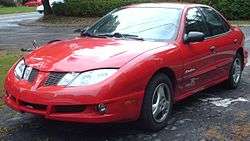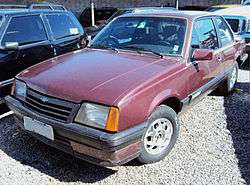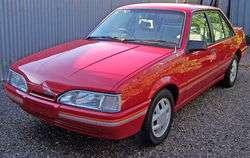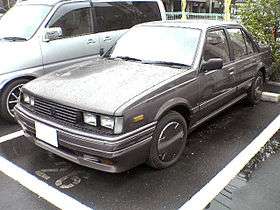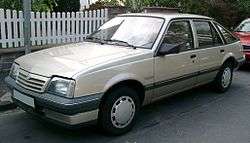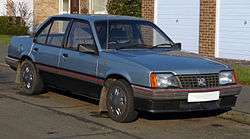GM J platform
The General Motors J platform, or J-body, is an automobile platform that was used by General Motors from 1981 to 2005. Marking the transition to front-wheel drive in the compact-car segment in North America, the J platform was the successor to the H platform, making it the third generation of compact cars designed by the company. Outside North America, the J platform was adopted by GM-controlled subsidiaries making the same transition to front-wheel drive, though as a mid-size car.
| J-body | |
|---|---|
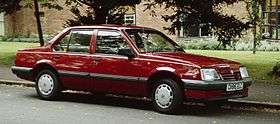 A 1987 Vauxhall Cavalier II, the Vauxhall version of the GM J-body. | |
| Overview | |
| Manufacturer | General Motors |
| Production | 1981–2005 |
| Body and chassis | |
| Class | Compact (North America) Mid-size (Global) |
| Layout | FF layout |
| Body style(s) | 2-door convertible 2-door coupe 2-door notchback sedan 3-door hatchback 4-door sedan 5-door station wagon 5-door hatchback |
| Chronology | |
| Predecessor | GM H platform (RWD) (North America) |
| Successor | GM2900 platform (Europe) GM Delta (North America) |
By 1990, General Motors began to reduce its usage of the J platform, reducing its usage of badge engineering. As the company prepared the launch of the Saturn S-Series for 1990, Buick and Oldsmobile ended their use of the J platform. Outside of North America, the J platform was phased out in favor of the GM2900 platform (cars based upon the Opel Vectra). With its highest sales under the Chevrolet and Pontiac brands, the J platform remained in production into the 2000s, following several redesigns.
Replaced by the GM Delta platform, General Motors ended production of the J-platform in June 2005, with a Pontiac Sunfire as the final example.
Background
The design of the J-body began in the mid 1970s. At that time, GM-controlled divisions in different parts of the world manufactured totally different rear-wheel drive C-segment cars – the Chevrolet Vega in America, the Vauxhall Cavalier/Opel Ascona in Europe, the Holden Torana in Australia and the Isuzu Florian in Japan. It was decided that a common replacement would be developed to eliminate duplication of engineering effort and ensure parts interchangeability – a practice known as badge engineering or platform-sharing. When the Arab Oil Embargo forced Corporate average fuel economy mandates, and the fear of US$3.00 for a gallon of gasoline, the J-body was practically produced straight off the drawing board.
In continental Europe, the car was sold as the Opel Ascona. In Britain, it was known as the Vauxhall Cavalier. Irrespective of badging, European production of the J-body occurred in plants in Germany, Belgium, and Britain.[1] It was generally well received but was narrowly beaten to the European Car of the Year accolade by the Renault 9. The Vauxhall Cavalier version was particularly successful in Britain, where it was the second best selling car in 1984 and 1985 and managed around 800,000 sales across a seven-year production run.[2] At the time, it set new standards for performance and economy in this size of car in Europe; for instance, the 1.6 petrol engined Cavalier for the British market had a top speed of 105 mph, compared to the 101 mph top speed of the 2.0 petrol engined Ford Cortina – its key competitor for a year until the Ford Sierra was launched in 1982.[1] Due to the exterior dimensions, and the engines offered being in compliance with Japanese regulations, the platform was classed in the favorable "compact" designation allowing the Isuzu Aska to compete with other Japanese made products sold in the domestic market at the time. Isuzu also supplied kits for Holden's J-car version, the Camira.[3]
The fourth character in the Vehicle Identification Number for a J-body car is "J".
Models
Over its 24-year production run, the GM J platform would be sold under 16 different nameplates (five under the Pontiac brand alone). In North America, during the 1980s, every division of General Motors except for GMC sold a variant of the J platform.
Aside from several cosmetic redesigns (in 1988 and 1995) along with major powertrain revisions, the J-platform saw few fundamental changes during its production run.
| Vehicle Name | Years Produced | Body Styles | Notes |
|---|---|---|---|
| North American-market nameplates | |||
| Buick Skyhawk
|
1981*–1989 | 2-door sedan 4-door sedan 3-door hatchback 5-door station wagon (1983-88) | The 1989 Buick Skyhawk would be the last Buick sold with a manual transmission until 2011. |
| Cadillac Cimarron
|
1981*–1988 | 4-door sedan | The Cadillac Cimarron shared most of its body panels with the Chevrolet Cavalier, becoming one of the most infamous examples of automotive badge engineering. |
| Chevrolet Cavalier
|
1981*–2005 | 2-door sedan 2-door coupe 2-door convertible 4-door sedan 3-door hatchback 5-door station wagon | Longest-produced and best-selling J-body. |
| Oldsmobile Firenza
|
1981*–1988 | 2-door sedan 4-door sedan 3-door hatchback 5-door station wagon (1983-88) | The Oldsmobile Firenza is the shortest-produced version of the J-platform in North America. |
| Pontiac J2000
Pontiac 2000
|
1981*-1982 (J2000) 1982-1983 (2000) 1983-1984 (2000 Sunbird) 1984–1994 (Sunbird) |
2-door sedan 2-door coupe 2-door convertible 4-door sedan 3-door hatchback 5-door station wagon | |
| Pontiac Sunfire
|
1994–2005 | 2-door coupe 2-door convertible 4-door sedan | The Sunfire replaced the Sunbird as part of a major redesign of the J-platform for 1995. |
| Global-market nameplates | |||
| Chevrolet Monza
|
1982–1996 | 2-door sedan 4-door sedan 3-door hatchback | Produced in Brazil, the Monza is a version of the Opel Ascona.
3-door hatchbacks have different (more upright) rooflines than the North American versions. |
| Daewoo Espero/Aranos
|
1990–1997 | 4-door sedan | Only version of the J-platform using a body styled by Bertone |
| Holden Camira
|
1982–1989 | 4-door sedan 5-door station wagon | The body of the Camira station wagon served as the basis for the Vauxhall Cavalier wagon in the UK. |
| Isuzu Aska
|
1983–1989 | 4-door sedan | The Aska was sold as a Chevrolet in South America, and briefly as the Holden JJ Camira in New Zealand. |
|
|
1982–1988 |
Opel:
2-door sedan Vauxhall:
2-door sedan |
The Ascona/Cavalier are badge-engineered vehicles, with the Opel sold in continental Europe and the Vauxhall sold in Great Britain. Station wagon body panels are derived from the Holden Camira produced in Australia. |
| Toyota Cavalier
|
1995–2000 | 2-door coupe 4-door sedan | In a trade agreement between Toyota and GM, the Cavalier was imported into Japan in return for the USDM Geo-division cars for Chevrolet. Toyota Cavaliers are right-hand drive with other detail changes to meet Japanese regulations. |
In all cases, final assembly of convertibles was subcontracted by General Motors; in North America by American Sunroof Corporation (ASC); in Brazil by Envemo and Sulam – and in Europe by Baur. Convertibles for the German market were assembled by Keinath and Hammond & Thiede.
(*) Across all US brands, introduction was in spring 1981 but the launch versions were all advertised as 1982 model year cars.
Approximately 10,150,000 GM J platform cars were sold across eleven marques on six continents from 1982 through 1997, not counting Daewoo Espero sales.[4][5][6][7] Consequently, it is the fifth best selling automobile platform in automotive history.
References
- Hayward, Matthew (June 28, 2011). "Vauxhall Cavalier Mk2: Vauxhall's new pragmatism..." AROnline. Retrieved September 4, 2013.
- "Previous winners". Car of the year. Archived from the original on February 21, 2015. Retrieved September 18, 2010.
- "GM ties with two Japanese car makers". Nihon Keizai Shimbun. Tokyo: 1. August 18, 1981.
- Flammang, James Standard Catalog of American Cars 1976–1999 3rd Edition (Iola, WI: Krause Publications, Inc 1999)
- "International 1st Gen Jbodies – First Generation Forum". j-body.org. Retrieved February 16, 2012.
- "Overview". Ascona. Archived from the original on March 30, 2012.
- "Chevrolet Monza". Chevy Wiki. February 9, 2009. Retrieved February 16, 2012.

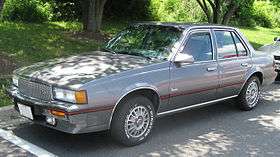
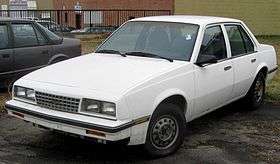



.jpg)


